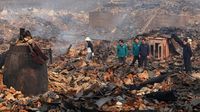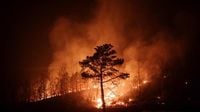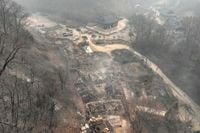In a devastating series of wildfires that have swept through South Korea's southeastern region, at least 24 people have lost their lives, making this one of the most catastrophic wildfire outbreaks in the country's history. The fires, which began on March 22, 2025, have forced over 27,000 residents to evacuate their homes and have destroyed more than 200 structures, including ancient temples and homes.
The scale of the disaster has prompted a massive response from authorities, with thousands of firefighters and military personnel deployed to combat the blazes. Acting President Han Duck-soo described the situation as one of the worst wildfires in history, stating, "We are deploying all available personnel and equipment in response to the worst wildfires in history, but the situation remains dire." The urgency of the situation is underscored by the fact that numerous neighborhoods have been obliterated, schools have closed, and even prisons have evacuated inmates for their safety.
As of Wednesday morning, March 26, 2025, the Safety Ministry reported that 14 deaths were linked to a fire in Uiseong county, while another 10 were attributed to a separate blaze in Sancheong county. Tragically, the majority of the victims were elderly individuals aged in their 60s and 70s, according to local police official Son Chang-ho.
The Uiseong fire, which is only 68% contained, continues to rage, exacerbated by gusty winds and dry conditions that are expected to persist in the region for the coming days. Forest disaster expert Lee Byung-doo from the National Institute of Forest Science characterized the fire's scale and speed as "unimaginable," emphasizing the urgent need for more resources and trained personnel to combat the flames. Lee noted that similar wildfires have occurred in places like Los Angeles and Japan earlier this year, indicating a troubling trend linked to climate change.
In a tragic turn of events, a firefighting helicopter crashed while attempting to extinguish a blaze, killing the pilot. This incident has raised concerns about the technical issues facing South Korea's fleet of firefighting helicopters, many of which have been grounded due to sanctions related to the Ukraine war. As the government faces criticism over the apparent shortage of firefighting equipment, a total of 4,919 personnel, including police officers and military units, were deployed on Wednesday, along with 87 helicopters to combat the flames.
The wildfires have wreaked havoc on South Korea's cultural heritage, destroying ancient landmarks and threatening UNESCO World Heritage sites such as Hahoe Village and the Byeongsan Confucian Academy in Andong city. Gounsa, a historic Buddhist temple dating back to the 7th century, has been reduced to ashes. Authorities are making efforts to protect these cultural treasures by spraying fire retardants in the vicinity.
As the wildfires continue to devastate the region, the government has designated the affected areas as special disaster zones. The fires have burned through more than 15,000 hectares (approximately 37,065 acres) of land, causing widespread environmental damage and significant loss of cultural heritage.
In addition to the immediate human toll, the wildfires have also raised questions about the factors contributing to their severity. Authorities suspect that human error may have sparked some of the fires, highlighting the need for improved fire management and prevention strategies in the future.
The U.S. military in Korea has also offered assistance in tackling the wildfires, reflecting the international solidarity in the face of this environmental crisis. The ongoing situation has drawn attention to the increasing frequency of wildfires globally, with climate change being cited as a major factor in their rise.
As South Korea grapples with this unprecedented disaster, the focus will be on recovery efforts and ensuring the safety of residents affected by the wildfires. With the situation still developing, authorities continue to monitor the fires closely and adapt their strategies in response to the evolving circumstances.
In summary, the wildfires in South Korea have resulted in tragic loss of life, widespread destruction, and significant challenges for firefighting efforts. As the country faces one of its worst wildfire outbreaks in history, the need for effective response and recovery measures is more critical than ever.







